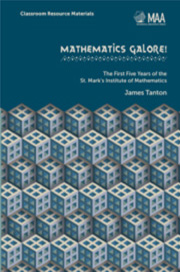Book contents
- Frontmatter
- Contents
- Introduction
- Newsletters and Commentaries
- Appendices
- I Numbers that are the Sum of Two Squares
- II Pick's Theorem
- III The Möbius Function
- IV The Borsuk-Ulam Theorem
- V The Galilean Ratios
- VI A Candy-Sharing Game
- VII Bending Buffon's Needle
- VIII On Separating Dots
- Index of Topics
- Classic Theorems Proved
- About the Author
I - Numbers that are the Sum of Two Squares
from Appendices
- Frontmatter
- Contents
- Introduction
- Newsletters and Commentaries
- Appendices
- I Numbers that are the Sum of Two Squares
- II Pick's Theorem
- III The Möbius Function
- IV The Borsuk-Ulam Theorem
- V The Galilean Ratios
- VI A Candy-Sharing Game
- VII Bending Buffon's Needle
- VIII On Separating Dots
- Index of Topics
- Classic Theorems Proved
- About the Author
Summary
One of the many joys and pleasures in working with young students on a varied array of topics is that they spur you to think about a wide spectrum of mathematical questions. During our work on the Stern-Brocot tree one semester (newsletter 21) I wondered if it is possible to use the tree to prove that every prime one greater than a multiple of four is a sum of two squares. (I could see a connection between the continued fractions we were exploring and the numerators of certain fractions that appeared in the tree.) These thoughts did not apply to where the students wanted to go and were at a level too advanced for the group, so I didn't share them with the class. But I did explore them.
I didn't end up making use of the tree directly in my thinking, but I came to a point where I could prove the classification result mentioned in newsletter 12.
N is a sum of two squares if and only if each prime that is one less a multiple of four (3, 7, 11, 19, 23, …) that appears in the prime factorization of N does so an even number of times.
This is a classic result in number theory discussed – and proved – in many texts. (See [HARDY and WRIGHT], for example.)
The following represents a series of steps that establishes the classification, indirectly inspired by students of the St. Mark's Math Institute.
- Type
- Chapter
- Information
- Mathematics Galore!The First Five Years of the St. Mark's Institute of Mathematics, pp. 221 - 230Publisher: Mathematical Association of AmericaPrint publication year: 2012

